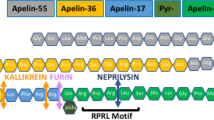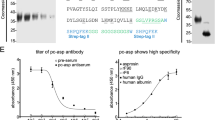An artificial hormone taken to boost athletic performance can now be detected.
Abstract
Erythropoietin is a hormone that stimulates the production of new red blood cells (erythropoiesis). Although athletes use recombinant human erythropoietin illicitly to boost the delivery of oxygen to the tissues and enhance their performance in endurance sports, this widespread doping practice cannot be controlled in the absence of a reliable analytical procedure to monitor it. Here we describe a new technique for detecting this drug in urine following its recent administration.
Similar content being viewed by others
Main
The stimulation of erythropoiesis by erythropoietin (EPO) makes this drug very attractive to sportspeople wishing to improve their aerobic power, although the International Olympic Committee banned its misuse ten years ago. Detection has been a problem — analysis of haematological1 or biochemical2 parameters indicates only that erythropoiesis has been stimulated, but cannot confirm that drug administration is to blame.
To detect administered hormone directly means that exogenous, recombinant EPO must be differentiated from natural, endogenous EPO. A promising electrophoretic method3 has proved impractical for screening by the antidoping laboratories. We have developed an analytical procedure for detecting recombinant EPO in urine and have applied it to specimens from cyclists participating in the the infamous Tour de France 1998 competition, which was sullied by scandals about EPO doping.
Owing to microheterogeneity in their structures, natural and recombinant EPO comprise several isoforms, some of which have charge differences and can be separated by isoelectric focusing (Fig. 1). We found that the isoelectric patterns of the two recombinant EPO-α and -β forms are very similar (both have an isoelectric point, pI, in the range 4.42–5.11); although EPO-β has an extra basic band, both differ from natural, purified urinary EPO, which has more acidic bands (pI 3.92–4.42), probably due to post-translational modifications such as glycosylation, which is species- and tissue-type-dependent4. Such differences in the urine analysis allowed us to ascribe excreted EPO to a natural or recombinant origin.
Images were obtained by chemiluminescent immunodetection of blotted EPO after isoelectric focusing. a, Purified commercial human urinary natural EPO (Sigma); b, recombinant EPO-β (Neorecormon, France); c , recombinant EPO-α (Eprex, France); d, urine from a control subject; e,f, urine from two patients treated with Neorecormon EPO for post-haemorrhagic anaemia; g,h, urine from two cyclists from Tour de France 1998 (samples concentrated by ultrafiltration). Note the ‘mixed’ appearance of the pattern in e. The cathode is at the top; pH values are indicated on the left.
We developed an immunoblotting procedure to obtain a reliable image of EPO patterns in urine. Our results (Fig. 1) indicated that the patterns from control subjects consisted of about 10 bands of pI 3.77–4.70, in accord with the purified natural urinary EPO pattern, whereas those from subjects treated with recombinant EPO contained more basic bands, reflecting the presence of recombinant isoforms, and sometimes acidic bands as well, depending on the presence of endogenous isoforms. The presence of exogenous hormone was always evident: any individual injected with recombinant EPO showed a striking transformation of their initial EPO urine pattern.
We assayed 102 frozen urine samples from participants in the Tour de France 1998 cycling competition for EPO by using an enzyme-linked immunosorbent assay. Twenty-eight of these samples had EPO levels above the normal range of 0–3.7 international units per litre (mean, 0.48 IU per litre, n=103; 77 samples were below the minimum detectable concentration of 0.6 IU per litre). We analysed the 14 samples presenting with the highest concentrations (7–20 IU per litre): although characterization of the EPO source does not require such high levels for urine analysis, we selected these samples for isoelectric focusing as they were more likely to contain exogenous hormone; indeed, they all gave rise to a banding pattern typical of recombinant hormone.
Our method for detecting recent exposure to recombinant EPO in athletes could be useful for in-competition controls in events of long duration (for example, cyclists have been known to use exogenous EPO continuously for 6 months at a time), but should find its principal application in out-of-competition testing.
References
Casoni, I. et al. Int. J. Sports Med. 14, 307– 311 (1993).
Gareau, R. et al. Nature 380, 113 ( 1996).
Wide, L. et al. Med. Sci. Sports Exerc. 27, 1569– 1576 (1995).
Rademacher, T. W., Parekh, R. B. & Dwek, R. A. Annu. Rev. Biochem. 57, 785 –838 (1988).
Author information
Authors and Affiliations
Rights and permissions
About this article
Cite this article
Lasne, F., de Ceaurriz, J. Recombinant erythropoietin in urine. Nature 405, 635 (2000). https://doi.org/10.1038/35015164
Issue Date:
DOI: https://doi.org/10.1038/35015164
This article is cited by
-
A Reference Standard for Analytical Testing of Erythropoietin
Pharmaceutical Research (2022)
-
Cross-platform transcriptomic profiling of the response to recombinant human erythropoietin
Scientific Reports (2021)
-
Facile imprinted polymer for label-free highly selective potentiometric sensing of proteins: case of recombinant human erythropoietin
Analytical and Bioanalytical Chemistry (2021)
-
Validation of whole-blood transcriptome signature during microdose recombinant human erythropoietin (rHuEpo) administration
BMC Genomics (2017)
-
Analytics of nonpeptidic erythropoietin mimetic agents in sports drug testing employing high-resolution/high-accuracy liquid chromatography-mass spectrometry
Analytical and Bioanalytical Chemistry (2016)
Comments
By submitting a comment you agree to abide by our Terms and Community Guidelines. If you find something abusive or that does not comply with our terms or guidelines please flag it as inappropriate.




